Shed Material: Wood vs Plastic vs Metal?
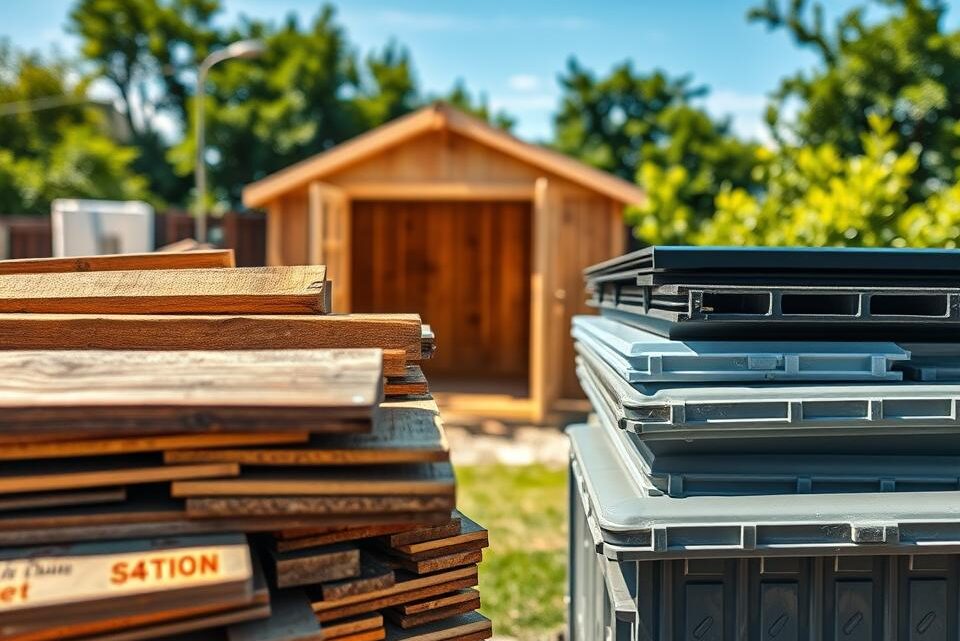
Selecting the perfect construction option for your garden shed ranks amongst the most crucial choices when planning your outdoor storage solution. Your decision will directly influence durability, upkeep demands, and long-term performance.
Whether you’re storing gardening equipment, establishing a workshop area, or organising household items, the construction type significantly affects your investment’s value. Each option brings distinct advantages and considerations that deserve careful evaluation.
This comprehensive guide examines three popular building options available across Britain: timber, synthetic materials, and steel structures. We’ll explore each option’s unique characteristics, benefits, and potential limitations.
Understanding these differences ensures you’ll invest wisely in a structure that delivers reliable service whilst enhancing your property’s visual appeal. The right choice depends on your specific requirements, budget constraints, and environmental conditions.
Inhaltsverzeichnis
Key Takeaways
- Construction material choice significantly impacts durability, maintenance requirements, and overall performance of your outdoor storage structure
- Timber options offer natural aesthetics but require regular maintenance and weather protection treatments
- Synthetic materials provide excellent weather resistance with minimal upkeep but may lack traditional visual appeal
- Steel structures deliver superior strength and security whilst requiring occasional rust prevention measures
- Budget considerations should include both initial costs and long-term maintenance expenses for each material type
- Local climate conditions and intended usage patterns influence which construction option performs best in your specific situation
Understanding Your Shed Material Requirements
Determining your shed material needs requires careful consideration of multiple factors that will influence both performance and satisfaction with your garden structure. Each material option brings distinct advantages and challenges that must align with your specific circumstances. Taking time to evaluate these requirements upfront prevents costly mistakes and ensures your shed construction project delivers lasting value.
Your decision-making process should encompass practical considerations alongside aesthetic preferences. The most expensive material isn’t always the best choice for your situation. Similarly, the cheapest option might prove costly over time if it doesn’t meet your durability requirements.
Assessing Your Garden Space and Usage Needs
Your garden’s unique characteristics play a crucial role in determining suitable materials for your garden building project. Measure the available space carefully, noting any slopes, drainage issues, or proximity to trees and boundaries. These factors influence foundation requirements and material selection.
Consider how you intend to use your shed daily. Storage needs differ significantly from workshop requirements. Heavy machinery storage demands robust flooring and structural integrity. Conversely, simple garden tool storage allows for lighter construction approaches.
Think about access requirements too. Wide doors suit lawnmower storage, whilst multiple smaller openings work better for general garden equipment. Your usage patterns determine whether you need natural lighting, electrical provisions, or enhanced security features.
Budget Planning for Your Shed Project
Effective budget planning extends well beyond the initial purchase price of your chosen material. Foundation preparation costs vary significantly between materials, with some requiring concrete bases whilst others work with simpler gravel foundations.
Installation expenses represent another major consideration. Some materials arrive as complete kits requiring minimal assembly, whilst others need professional installation. Factor in tool hire, additional materials, and potential labour costs when comparing options.
“A realistic budget should account for at least 30% additional costs beyond the shed price for proper installation and setup.”
Long-term maintenance costs deserve equal attention. Wooden structures require regular treatment, whilst metal options might need rust prevention measures. Plastic sheds typically demand minimal ongoing investment but may require occasional repairs.
| Cost Category | Wood Sheds | Plastic Sheds | Metal Sheds |
|---|---|---|---|
| Initial Purchase | £300-£2000 | £200-£800 | £150-£1200 |
| Foundation Costs | £100-£400 | £50-£200 | £80-£300 |
| Annual Maintenance | £30-£80 | £5-£20 | £15-£40 |
| 10-Year Total | £700-£3200 | £300-£1200 | £380-£1900 |
Local Planning Permission Considerations
Most garden buildings fall under permitted development rights in the UK, allowing construction without formal planning applications. However, specific restrictions apply that could affect your material choices and shed dimensions.
Sheds exceeding 2.5 metres in height require planning permission in most areas. Similarly, structures within two metres of boundaries face height restrictions. These limitations might influence whether you choose materials that maximise internal space efficiency.
Conservation areas and listed buildings face additional restrictions. Local planning authorities often specify approved materials and design requirements. Check with your council before proceeding with shed construction in these sensitive locations.
Building regulations apply to larger structures or those with electrical installations. While most garden sheds remain exempt, understanding these requirements helps avoid compliance issues. Some materials naturally meet building standards more easily than others, potentially simplifying approval processes for larger projects.
Wooden Sheds: Characteristics and Benefits
Natural timber construction offers garden shed owners a perfect blend of functionality and visual charm. Wood has maintained its position as the most sought-after material for British gardens, combining practical benefits with undeniable aesthetic appeal. The versatility of wooden sheds makes them suitable for diverse applications, from simple storage to sophisticated workshop spaces.
Understanding the different timber options available helps you make an informed decision for your garden project. Each wood type brings distinct advantages that cater to specific needs and budgets.
Pressure-Treated Timber vs Cedar Options
Pressure-treated timber represents excellent value for money whilst delivering reliable performance in the British climate. This weather resistant option undergoes chemical treatment that penetrates deep into the wood fibres. The process creates a barrier against rot, fungal decay, and insect damage.
Cedar stands as the premium choice for discerning homeowners who prioritise natural solutions. This remarkable timber contains natural oils that repel insects and resist moisture without requiring chemical treatments. Cedar develops an attractive silver-grey patina over time, adding character to your garden landscape.
The cost difference between these options reflects their respective benefits. Pressure-treated timber offers affordability and proven durability, whilst cedar provides superior longevity and environmental credentials.
Natural Insulation and Aesthetic Appeal
Wood’s natural insulation properties create a significant advantage over alternative materials. The cellular structure of timber traps air, providing excellent thermal regulation that keeps your shed comfortable year-round. This natural insulation prevents condensation buildup and maintains stable internal temperatures.
The aesthetic appeal of wooden sheds remains unmatched in garden settings. Timber blends seamlessly with natural surroundings, creating harmony between your storage solution and existing landscape features. Wood grain patterns and natural textures add visual interest that synthetic materials simply cannot replicate.
Many homeowners find that wooden sheds actually enhance their property’s overall appearance. The organic warmth of timber creates an inviting focal point that complements both traditional and contemporary garden designs.
Customisation and Extension Possibilities
Wooden sheds offer unlimited potential for personalisation and future modifications. The workable nature of timber allows for easy shed installation of additional features such as windows, ventilation systems, or electrical fittings. You can transform a basic storage shed into a fully equipped workshop or garden office.
Extension possibilities with wooden construction are virtually limitless. Adding lean-to sections, increasing height, or incorporating covered storage areas becomes straightforward with proper planning. This adaptability makes wooden sheds an excellent long-term investment that grows with your changing needs.
The ability to paint, stain, or treat wooden sheds means you can refresh their appearance whenever desired. This flexibility allows you to match changing garden themes or property improvements without replacing the entire structure.
Plastic Sheds: Modern Material Advantages
High-density polyethylene sheds represent a breakthrough in outdoor storage solutions for UK homeowners. These innovative structures combine cutting-edge materials science with practical garden storage needs. Unlike traditional materials, plastic sheds offer a maintenance-free approach to outdoor storage that suits busy modern lifestyles.
The advanced manufacturing processes create structures that withstand Britain’s unpredictable weather patterns. Virtually immune to the common problems that plague other materials, these sheds eliminate concerns about rot, rust, and insect damage. This reliability makes them particularly attractive for homeowners seeking long-term storage solutions.
High-Density Polyethylene Construction
The foundation of modern plastic shed technology lies in high-density polyethylene (HDPE) construction. This engineered material delivers exceptional shed durability through its molecular structure. The polymer chains create a robust framework that resists impact damage and structural deformation.
HDPE manufacturing involves precise temperature control and pressure application. This process results in a material that maintains its integrity across temperature ranges typical of UK climates. The construction method eliminates weak points commonly found in traditional building materials.
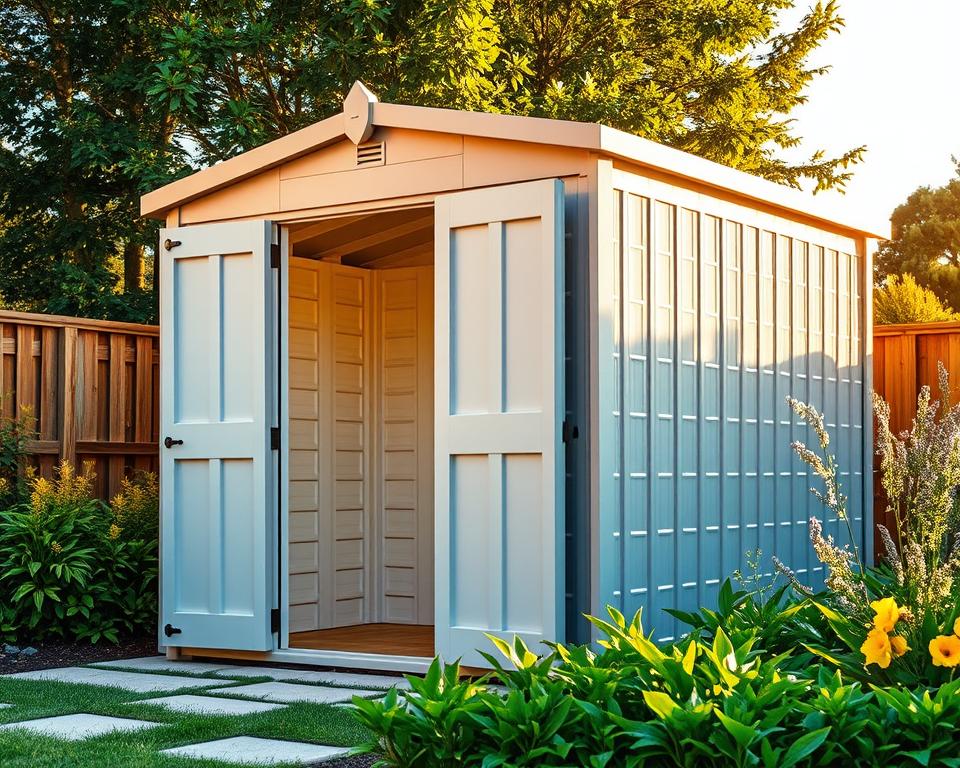
Professional-grade HDPE offers superior performance compared to standard plastic alternatives. The material’s density provides structural strength whilst remaining lightweight enough for easy handling during assembly. This combination makes installation significantly more manageable than heavier alternatives.
UV Resistance and Colour Retention
Built-in UV stabilisers protect plastic sheds from Britain’s varying sunlight conditions. These additives prevent the material degradation that typically affects outdoor structures. The result is consistent performance regardless of seasonal weather changes.
Colour retention technology ensures sheds maintain their appearance for years without fading. The pigments integrate directly into the material during manufacturing rather than being applied as surface coatings. This approach provides lasting visual appeal that enhances garden storage areas.
Temperature fluctuations that cause cracking in other materials have minimal impact on quality HDPE construction. The material’s flexibility allows it to expand and contract without structural compromise. This characteristic proves particularly valuable during harsh winter conditions.
Modular Design and Easy Assembly
Contemporary plastic sheds feature intelligent modular design systems that simplify installation processes. Pre-manufactured panels connect through innovative locking mechanisms that require only basic tools. Most homeowners can complete assembly within a single weekend.
The modular approach eliminates complex cutting or fitting procedures. Each component arrives precisely manufactured to ensure perfect alignment during construction. This precision reduces assembly time whilst improving overall shed durability through proper structural connections.
Reinforced panel systems provide excellent security features without compromising ease of assembly. Integrated locking points and strengthened door frames offer peace of mind for valuable stored items. These security enhancements integrate seamlessly into the overall design without adding complexity to the installation process.
Metal Sheds: Durability and Security Features
When durability and protection matter most, metal construction delivers unmatched performance. These robust structures excel in demanding environments where other building materials might falter. Metal sheds provide exceptional value for homeowners seeking long-term storage solutions with minimal maintenance requirements.
The inherent strength of metal construction makes these sheds ideal for storing valuable equipment, tools, and machinery. Their resistance to impact damage and forced entry attempts sets them apart from alternative materials. Additionally, metal sheds maintain structural integrity across decades of use.

Galvanised Steel vs Powder-Coated Aluminium
Galvanised steel represents the most cost-effective metal option for shed construction. This material undergoes a zinc coating process that provides excellent corrosion resistance. Steel sheds offer superior strength and can withstand significant impact without denting or damage.
Powder-coated aluminium delivers premium rust protection and weighs considerably less than steel alternatives. This lighter weight simplifies transportation and assembly processes. The powder coating creates a durable finish that resists scratching and maintains colour vibrancy for years.
When conducting a shed comparison, consider that aluminium costs more initially but requires less foundation support. Steel provides maximum security but demands proper drainage to prevent moisture accumulation. Both materials offer excellent longevity when properly installed.
Fire Resistance and Security Benefits
Metal construction provides outstanding fire resistance compared to wooden or plastic alternatives. This characteristic makes metal sheds particularly suitable for storing flammable materials safely. Petrol, oils, and workshop chemicals can be housed with greater confidence in metal structures.
Security features represent a major advantage of metal shed construction. Reinforced doors, robust locking mechanisms, and panels that resist cutting tools deter theft attempts. Many models include multi-point locking systems and reinforced hinges for enhanced protection.
The solid construction prevents easy access through walls or roofing panels. This security advantage makes metal sheds ideal for storing expensive power tools, bicycles, and garden machinery. Insurance companies often recognise this enhanced security with reduced premiums.
Foundation Requirements and Anchoring
Proper foundation preparation proves essential for metal shed stability. These structures require level, well-drained bases to prevent water pooling and structural stress. Concrete slabs or reinforced gravel bases work best for most installations.
Secure anchoring prevents wind damage and ensures structural integrity during storms. Most metal sheds include ground anchors or require concrete fixing bolts. The anchoring system must match the foundation type and local wind load requirements.
Foundation costs vary significantly based on ground conditions and shed size. Professional installation often proves worthwhile for larger structures or challenging sites. Proper preparation and anchoring extend shed lifespan and maintain warranty coverage.
Comparing Weather Resistance Across Materials
The UK’s challenging weather patterns demand careful evaluation of each material’s ability to withstand rain, wind, and temperature changes. Your choice of shed material directly impacts how well your investment will perform against Britain’s notorious climate variability. Understanding these differences helps ensure your garden structures remain functional and attractive for years to come.
Weather resistance isn’t just about surviving storms. It encompasses daily moisture exposure, seasonal temperature swings, and the constant battle against UV degradation. Each material responds differently to these challenges, making your selection crucial for long-term satisfaction.
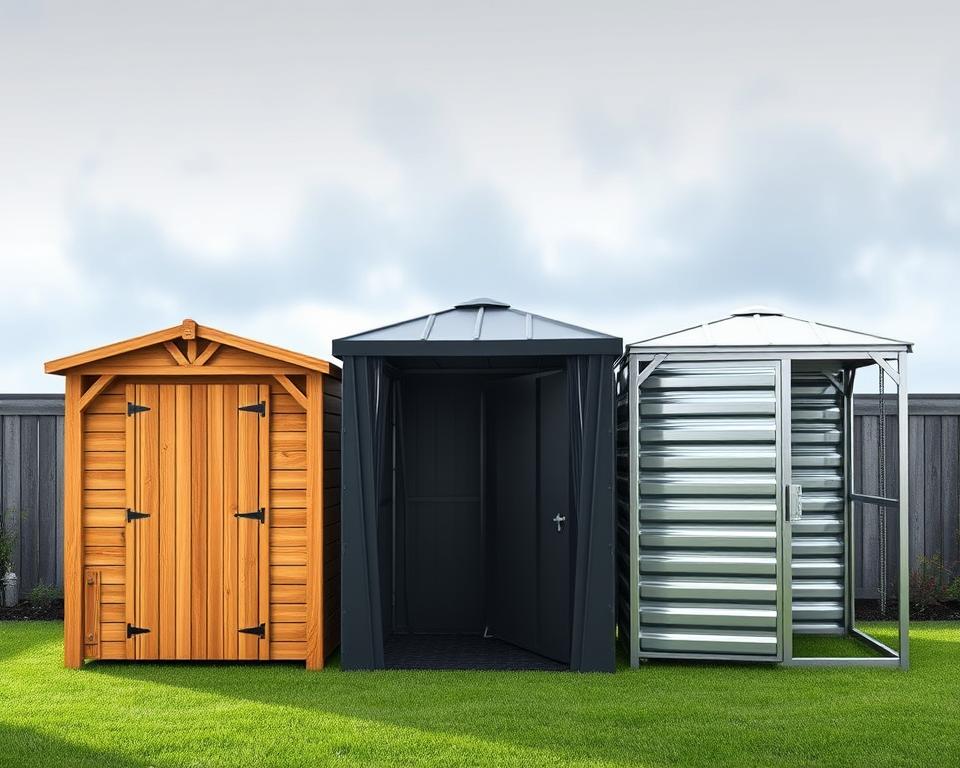
Rain and Moisture Protection
Wooden sheds naturally shed water when properly treated with quality preservatives. The timber’s grain structure channels moisture away from the surface. However, regular maintenance is essential to maintain this protection.
Untreated wood quickly absorbs moisture, leading to rot and structural weakness. Cedar naturally resists moisture better than pressure-treated pine, but both require annual treatment for optimal performance.
Plastic sheds excel in moisture resistance. High-density polyethylene won’t absorb water, eliminating rot concerns entirely. These materials perform consistently regardless of your shed foundation’s drainage quality.
Metal sheds provide excellent rain protection but face internal condensation challenges. Proper ventilation becomes critical to prevent moisture buildup inside the structure.
Wind Load Capacity
Wind resistance depends heavily on both material strength and anchoring quality. Metal sheds typically offer the highest wind resistance when properly secured to a solid shed foundation. Their rigid construction distributes wind loads effectively.
Well-built wooden sheds provide excellent wind resistance through their substantial frame construction. The natural flexibility of timber helps absorb wind forces without catastrophic failure.
Plastic sheds require careful consideration in exposed locations. While modern designs incorporate reinforcement features, proper siting and anchoring become even more important for these lighter structures.
Temperature Fluctuation Effects
Temperature changes affect each material differently throughout the seasons. Wood expands and contracts gradually, making it forgiving during temperature swings. This natural movement rarely causes structural issues.
Plastic materials remain remarkably stable across temperature ranges. Quality polyethylene maintains its shape and strength from winter freezing to summer heat without significant dimensional changes.
Metal experiences the most dramatic thermal movement. Steel and aluminium expand considerably in heat and contract in cold. Proper design accommodates this movement through expansion joints and flexible connections.
| Material | Rain Protection | Wind Resistance | Temperature Stability | Maintenance Need |
|---|---|---|---|---|
| Wood | Excellent when treated | Very Good | Good flexibility | Annual treatment |
| Plastic | Outstanding | Good with anchoring | Excellent stability | Minimal cleaning |
| Metal | Excellent exterior | Superior when anchored | High thermal movement | Rust prevention |
Maintenance Schedules and Long-term Care
Each shed material demands a unique approach to long-term care, with maintenance schedules varying significantly between wood, plastic, and metal options. Understanding these requirements helps you budget both time and money for your outdoor storage investment. The maintenance commitment you choose directly impacts your shed’s lifespan and performance over the years.
Proper care routines prevent costly repairs and ensure your shed construction remains structurally sound. Different materials require varying levels of attention, from intensive annual treatments to simple cleaning schedules. Planning your maintenance approach from the start helps you select the right material for your lifestyle.
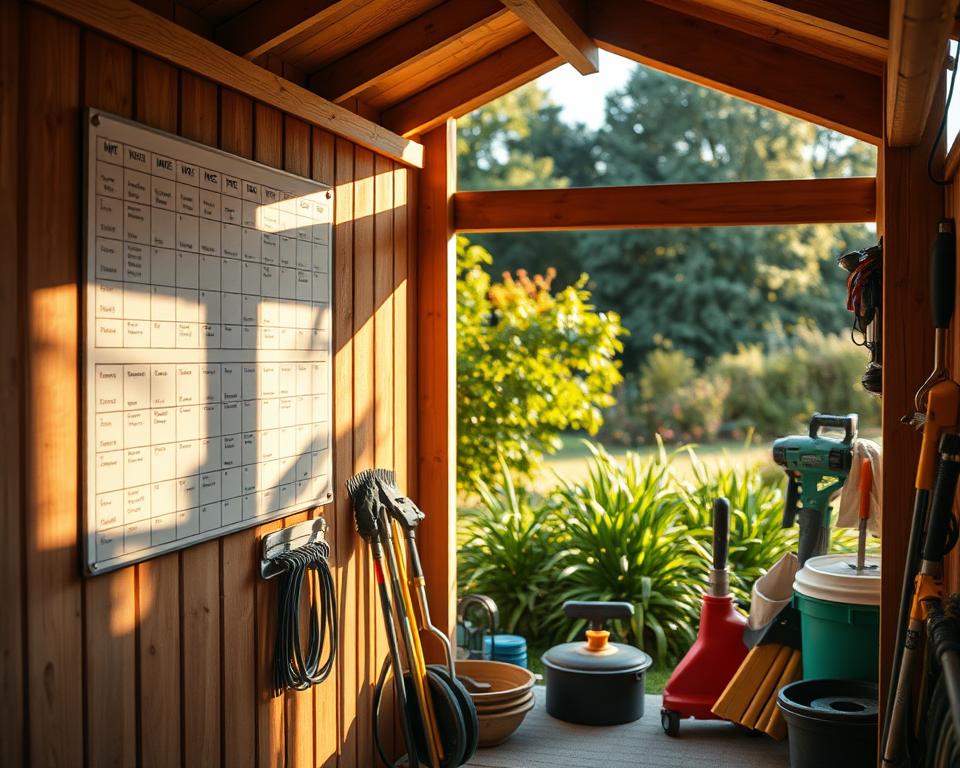
Annual Wood Treatment and Inspection
Wooden sheds require the most intensive maintenance schedule among all outdoor storage options. Annual treatment with preservative stains or paints maintains weather resistance and prevents timber decay. This process typically involves cleaning, light sanding, and applying protective coatings during dry weather conditions.
Budget around £30-50 annually for treatment products, depending on your shed’s size. The work usually takes a full weekend but significantly extends your shed’s lifespan. Pressure-treated timber requires less frequent treatment than standard softwood, but annual inspection remains essential.
Regular inspection catches problems before they become expensive repairs. Check for loose hinges, damaged roofing felt, and signs of rot around the base. Pay particular attention to areas where water might collect, such as door frames and window sills.
Plastic Shed Cleaning and Repair
Plastic sheds offer the lowest maintenance requirements in shed construction materials. Simple cleaning with mild detergent and warm water removes dirt, algae, and general grime. Most plastic surfaces resist staining and maintain their appearance with minimal effort.
Individual panel replacement provides an advantage when damage occurs. Rather than extensive repairs, you can replace specific sections without affecting the entire structure. This modular approach keeps long-term maintenance costs predictable and manageable.
Focus maintenance efforts on moving parts like hinges and locks. Regular lubrication ensures smooth operation and prevents premature wear. Check door alignment periodically, as plastic can expand and contract with temperature changes.
Metal Shed Rust Prevention
Metal sheds require vigilant rust prevention to maintain structural integrity. Regular inspection identifies problem areas before corrosion spreads throughout the outdoor storage structure. Pay special attention to joints, fixings, and areas where the protective coating might be damaged.
Prompt treatment of rust spots prevents expensive structural damage. Use rust converter products followed by matching touch-up paint to seal affected areas. This preventive approach costs far less than replacing corroded panels or framework.
Proper ventilation prevents condensation-related corrosion inside your shed. Ensure vents remain clear and consider adding moisture-absorbing products during humid periods. Galvanised steel requires less frequent attention than standard steel, but regular inspection remains important.
| Material Type | Annual Maintenance Cost | Time Investment | Key Tasks | Frequency |
|---|---|---|---|---|
| Wood | £30-50 | Weekend project | Treatment, inspection, repairs | Annual |
| Plastic | £5-15 | 2-3 hours | Cleaning, lubrication | Bi-annual |
| Metal | £15-25 | Half day | Rust prevention, touch-ups | Annual |
Understanding these maintenance commitments helps you choose materials that fit your available time and preferences. Consider your long-term commitment to shed construction care when making your initial purchase decision. The right choice balances upfront costs with ongoing maintenance requirements that suit your lifestyle.
Installation Process for Each Material Type
Getting your new garden building properly installed is crucial for long-term performance and durability. The shed installation process differs significantly between materials, affecting both the complexity and time required for completion. Understanding these differences helps you plan effectively and decide whether to tackle the project yourself or hire professionals.
Each material type presents unique challenges and benefits during installation. While some homeowners find certain materials more manageable, others may require specialist knowledge or tools. Professional installation remains an option for all materials, typically adding £200-500 to your project costs.
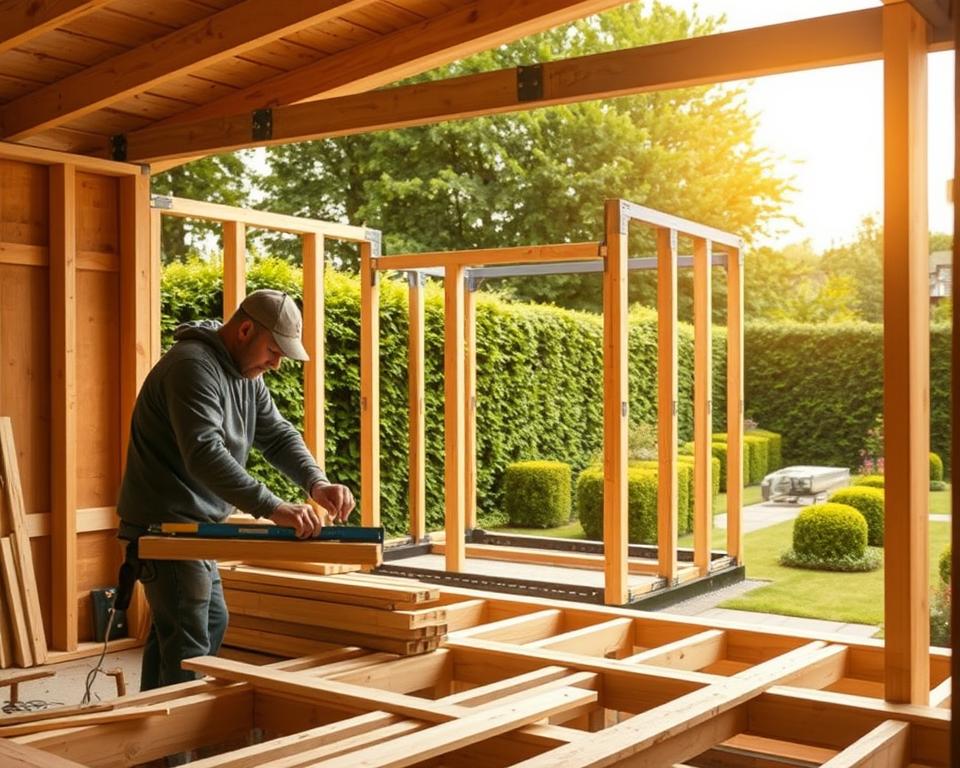
Foundation Preparation Requirements
All garden building installations begin with proper foundation preparation. The foundation must be level, well-drained, and appropriate for your chosen material. Poor foundation work compromises the entire structure’s integrity and may void warranty coverage.
Wooden sheds typically require concrete pads or treated timber bearers as foundations. The bearers should be pressure-treated and positioned to support the shed’s main structural points. Concrete pads offer superior longevity but require more preparation time and cost.
Plastic sheds often use proprietary plastic base systems or concrete slabs. Many manufacturers provide interlocking base panels that create a level, ventilated foundation. These systems speed up installation but may cost more than traditional concrete alternatives.
Metal sheds generally need concrete foundations for proper anchoring and stability. The concrete must cure fully before installation begins. Proper anchoring is essential for metal structures, as they’re more susceptible to wind damage without secure foundations.
Assembly Complexity and Time Investment
The complexity of shed installation varies dramatically between materials. Wooden sheds typically present the most challenging assembly process, often requiring carpentry skills and careful attention to detail. Most wooden sheds arrive as pre-cut panels that need precise alignment and weatherproofing.
A typical wooden shed installation takes 1-2 weekends for experienced DIY enthusiasts. The process involves assembling wall panels, installing roofing, fitting doors and windows, and applying weatherproofing treatments. Patience and precision are essential for achieving professional results.
Plastic sheds offer the simplest installation experience. Most feature clip-together panels with clear, step-by-step instructions. The lightweight components make handling easier, and the modular design reduces assembly errors. Most plastic shed installation projects complete within 4-8 hours.
Metal sheds fall between wood and plastic in terms of complexity. They require careful panel alignment and proper fastening techniques. The installation typically takes a full day, with particular attention needed for ensuring weatherproof joints and secure anchoring.
Tools and Skills Needed
Different materials demand varying tool sets and skill levels for successful installation. Wooden sheds require the most comprehensive tool collection, including saws, drills, hammers, levels, and measuring equipment. Carpentry experience proves invaluable for handling adjustments and ensuring square, level assembly.
Plastic sheds need minimal tools, usually just a screwdriver, rubber mallet, and measuring tape. The pre-formed components eliminate the need for cutting or complex adjustments. Basic DIY skills suffice for most plastic garden building installations.
Metal shed assembly requires moderate tool investment, including drills, spanners, and safety equipment. The sharp metal edges demand careful handling and appropriate protective gear. Attention to detail is crucial for achieving weatherproof seals and proper structural integrity.
| Material Type | Installation Time | Skill Level Required | Essential Tools | Professional Cost |
|---|---|---|---|---|
| Wood | 1-2 weekends | Intermediate-Advanced | Full carpentry kit | £300-500 |
| Plastic | 4-8 hours | Basic DIY | Screwdriver, mallet | £200-350 |
| Metal | 6-12 hours | Intermediate | Drill, spanners, safety gear | £250-400 |
| Foundation Prep | 1-2 days | Varies by type | Concrete tools/timber | £150-300 |
Consider your practical abilities, available time, and tool access when planning your shed installation. Poor installation can compromise performance, safety, and warranty coverage. If you’re uncertain about any aspect, professional installation provides peace of mind and ensures optimal results for your investment.
Cost Comparison: Purchase Price to Lifetime Value
The financial reality of shed ownership involves three distinct cost categories that determine long-term value. Many homeowners focus solely on the initial purchase price, but shed durability and ongoing expenses significantly impact your total investment over time.
Understanding these costs helps you make an informed decision that aligns with your budget and usage requirements. Each material type presents different financial considerations that extend well beyond the showroom price tag.
Initial Material and Delivery Costs
Plastic sheds typically offer the most budget-friendly entry point, with prices ranging from £200 to £800 depending on size and features. These lightweight structures keep delivery costs minimal due to their reduced weight and compact packaging.
Wooden sheds occupy the middle ground at £300 to £1,500, with cedar options commanding premium prices. The natural appeal and customisation potential justify the higher initial investment for many homeowners.
Metal sheds represent the highest upfront investment, ranging from £400 to £2,000 for quality units. Their substantial weight increases delivery charges, particularly for larger models requiring specialist transport.
Installation and Foundation Expenses
Foundation and assembly costs add £200 to £800 to your total project budget. Weather resistant metal sheds require the most substantial foundations, often needing concrete bases for proper anchoring and stability.
Wooden sheds typically need treated timber bases or concrete foundation strips. The moderate foundation requirements keep installation costs reasonable whilst ensuring adequate support.
Plastic sheds offer the most flexible foundation options. Their lightweight construction allows installation on level ground, paving slabs, or simple timber frameworks, reducing preparation expenses significantly.
Ongoing Maintenance Budget
Maintenance costs reveal the most dramatic differences between materials. Wooden sheds require annual treatment costing £30 to £50, plus periodic repairs for damaged sections or hardware replacement.
Over a typical 15-year lifespan, wooden shed maintenance can total £600 to £1,000. This includes preservative treatments, minor repairs, and occasional component replacement to maintain structural integrity.
Plastic sheds virtually eliminate ongoing maintenance expenses. Occasional cleaning with soapy water represents the extent of required care, making them extremely cost-effective long-term investments.
Metal sheds require minimal maintenance when properly treated. Quality powder-coated units may need occasional touch-ups, but well-constructed models can operate virtually maintenance-free for decades, maximising their lifetime value proposition.
Shed Material: Wood vs Plastic vs Metal? – Decision Framework
Your ideal garden storage solution emerges when you balance practical needs against material characteristics. This systematic approach ensures you select the shed material that delivers long-term satisfaction whilst fitting your budget and lifestyle requirements.
The key to successful shed comparison lies in prioritising your most important factors. Consider which aspects matter most to your situation before weighing the pros and cons of each material option.
Matching Materials to Intended Use
Your shed’s primary purpose should guide your material selection. Workshop applications demanding electrical installations and year-round comfort favour wooden construction with natural insulation properties.
Security-focused storage for valuable equipment points towards metal sheds with reinforced locking systems. Their robust construction deters break-in attempts whilst providing fire-resistant protection for power tools and machinery.
General garden storage for seasonal items, furniture, and basic tools works well with any material. Plastic sheds excel here due to their low maintenance requirements and weather-resistant properties.
“The best shed is one that matches your actual usage patterns, not just your initial intentions.”
Hobby enthusiasts requiring customisation options should lean towards wooden sheds. Their adaptable nature allows for shelving additions, window installations, and structural modifications that plastic and metal alternatives cannot accommodate.
Environmental Impact Considerations
Sustainability concerns increasingly influence modern purchasing decisions. Wooden sheds from certified sustainable forests offer excellent environmental credentials through carbon sequestration and renewable resource utilisation.
The manufacturing process matters significantly in environmental impact assessment. Plastic sheds often incorporate recycled materials and deliver extended service lives that offset their initial production footprint.
Metal construction provides ultimate recyclability at end-of-life whilst requiring energy-intensive manufacturing processes. However, their exceptional durability means fewer replacements over decades of use.
Local sourcing reduces transportation emissions regardless of material choice. British-manufactured options typically offer lower carbon footprints than imported alternatives whilst supporting domestic industry.
Resale Value and Property Enhancement
Property enhancement potential varies dramatically between shed materials. Wooden sheds consistently add perceived value to properties by complementing landscaping and architectural styles.
Estate agents frequently highlight quality wooden garden storage structures as selling points. Their natural appearance integrates seamlessly with garden designs whilst suggesting thoughtful property maintenance.
Well-maintained plastic sheds provide functional value without significant property enhancement. Their modern appearance suits contemporary properties but may appear incongruous in traditional settings.
Metal sheds offer neutral impact on property values unless specifically designed as architectural features. Their utilitarian appearance focuses on function rather than aesthetic contribution.
The final shed comparison decision should reflect your long-term property plans. Permanent residents benefit from investing in materials that enhance their living environment, whilst temporary occupants might prioritise cost-effectiveness and portability.
Conclusion
Choosing between wood, plastic, and metal for your outdoor storage solution depends on balancing your specific needs with practical considerations. Each of these building materials offers unique strengths that cater to different homeowner priorities.
Wood remains the preferred choice for those seeking natural beauty and customisation flexibility. Plastic sheds appeal to homeowners who value low maintenance and weather resistance. Metal options provide superior security and longevity for valuable equipment storage.
Your decision should reflect your maintenance preferences, budget constraints, and intended use. Consider the climate in your area, the items you plan to store, and how the shed will complement your garden’s appearance.
Before making your purchase, visit local suppliers to examine different building materials firsthand. Check the thickness of panels, quality of hardware, and warranty terms. Read customer reviews and speak with neighbours who own similar structures.
Remember that proper installation and regular care will extend your shed’s lifespan regardless of material choice. A well-selected outdoor storage building will serve your family for many years, making this investment decision worthwhile.
Take time to evaluate your requirements carefully. The right shed material will provide reliable service whilst enhancing your property’s functionality and value.
FAQ
Which shed material offers the best value for money?
Plastic sheds typically offer the best overall value when considering purchase price, minimal maintenance costs, and longevity. Whilst wooden sheds may have lower initial costs, they require annual treatment costing £30-50 plus potential repairs. Over a 15-year lifespan, plastic sheds often prove most economical due to their virtually maintenance-free nature.
Do I need planning permission for my garden shed?
Most garden sheds fall under permitted development rights in the UK, meaning you don’t need planning permission. However, larger structures or those in conservation areas may require approval. Check with your local planning authority if your shed exceeds standard size limits or if you live in a designated area.
How long do different shed materials typically last?
With proper maintenance, wooden sheds last 15-20 years, plastic sheds can last 20-25 years, and metal sheds often exceed 25 years. The actual lifespan depends on material quality, installation, local weather conditions, and maintenance frequency.
Which shed material provides the best security?
Metal sheds offer superior security with reinforced doors, robust locking mechanisms, and panels that resist forced entry. They’re ideal for storing valuable tools or equipment. Wooden sheds can be secured with additional locks and reinforcement, whilst plastic sheds offer moderate security suitable for general garden storage.
What’s the difference between pressure-treated timber and cedar for wooden sheds?
Pressure-treated timber offers excellent value with good rot and insect resistance through chemical treatment. Cedar is more expensive but naturally resists decay and insects without chemicals, developing an attractive silver-grey patina over time. Cedar also has superior natural weather resistance.
Are plastic sheds suitable for the UK climate?
Yes, modern high-density polyethylene (HDPE) sheds are excellent for UK weather conditions. They’re immune to rot, rust, and insect damage, whilst UV stabilisers prevent colour fading. They handle temperature fluctuations well and won’t crack or become brittle in cold weather.
How much maintenance do different shed materials require?
Wooden sheds require annual treatment with preservative stains or paints, plus regular inspections. Plastic sheds need only occasional cleaning with mild detergent. Metal sheds require periodic rust spot treatment and touch-up painting, plus ventilation maintenance to prevent condensation.
Which shed material is easiest to install?
Plastic sheds are typically easiest to install, with clip-together panels and clear instructions allowing completion in 4-8 hours using basic tools. Metal sheds take about a full day, whilst wooden sheds are most complex, often requiring carpentry skills and 1-2 weekends for completion.
Can I customise my shed after installation?
Wooden sheds offer unlimited customisation possibilities – you can easily add windows, shelving, electrical installations, or extend the structure. Metal and plastic sheds have limited modification options, though some accessories and shelving systems are available for specific models.
Do metal sheds have condensation problems?
Metal sheds can experience condensation issues due to their thermal conductivity, causing significant temperature fluctuations inside. Proper ventilation is essential to prevent moisture buildup. Installing vents and ensuring adequate airflow helps manage this common issue with metal construction.
What foundation do I need for different shed materials?
All sheds require level, well-drained foundations, but specifications vary. Wooden sheds often use concrete pads or treated timber bearers, plastic sheds may use plastic bases or concrete slabs, whilst metal sheds typically require concrete foundations for proper anchoring and wind resistance.
Which shed material is most environmentally friendly?
Wooden sheds from sustainably managed forests offer excellent eco-credentials with carbon sequestration benefits. Plastic sheds often incorporate recycled materials and have long service lives, whilst metal sheds provide ultimate durability and are fully recyclable at end-of-life. Each has environmental advantages depending on your priorities.

